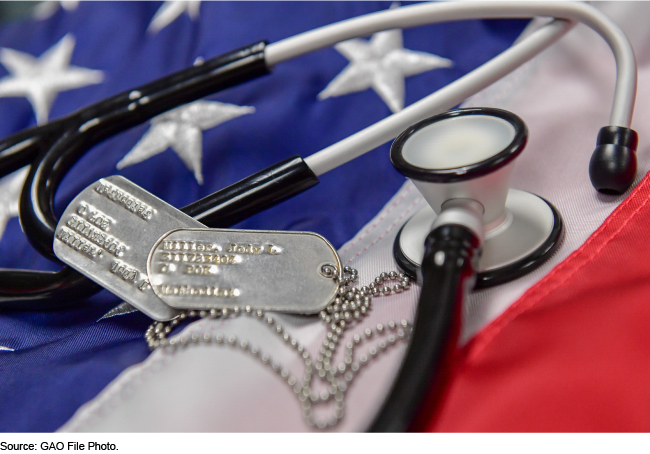DOD and VA Health Care: Suicide Prevention Efforts and Recommendations for Improvement
Fast Facts
Suicide is a public health problem facing all populations, and has been a persistent and growing issue for the nation's servicemembers and veterans.
We testified that the Departments of Defense and Veterans Affairs are taking steps to help prevent suicides among servicemembers and veterans by establishing prevention strategies and offices to oversee their efforts.
But we previously found that DOD needs to assess its non-clinical efforts, like suicide prevention training, for effectiveness. Also, the VA needs to ensure proper staffing levels for its local suicide prevention teams, and identify and analyze suicides that happen on its campuses.

Highlights
What GAO Found
Suicide is a public health problem facing all populations, and has been a persistent and growing issue for the nation's servicemembers and veterans. The Department of Defense (DOD) and the Department of Veterans Affairs (VA) have multiple efforts underway to help prevent suicide among military servicemembers and veterans. For example:
- DOD's suicide prevention approach includes both clinical and non-clinical efforts intended to reduce the risk of suicide. Clinical efforts include, for example, depression and suicide-specific screening in primary care and during periodic health assessments. Non-clinical efforts include activities such as educating commanders about safe and effective messaging and reporting regarding suicide and help-seeking.
- VA uses suicide prevention teams at facilities to implement its Suicide Prevention Program. Such teams perform programmatic, administrative, and clinical activities ranging from tracking and reporting on veterans at high risk for suicide to conducting training, collaborating with community partners, and consulting with providers.
Since September 2020, GAO has made three recommendations to DOD and six recommendations to VA to improve the agencies' suicide prevention efforts. As of November 2021, the agencies reported that they have taken initial steps to implement most of these recommendations and GAO continues to monitor their progress. Below are examples of GAO's findings and related recommendations.
- DOD non-clinical suicide prevention. In 2020, DOD published a framework for assessing the collective effect of the department's suicide prevention efforts by measuring outcomes linked to specific prevention strategies. However, this framework did not provide DOD with information on the effectiveness of individual non-clinical prevention efforts, such as training. GAO recommended that DOD develop a process to ensure that individual non-clinical suicide prevention efforts are assessed for effectiveness. DOD concurred and has begun to assess how to standardize its approach for evaluating program effectiveness.
- VA suicide prevention teams. VA uses a benchmark to help determine facilities' suicide prevention staffing needs; however, the benchmark may not accurately reflect facilities' staffing needs and has not accounted for increasing workloads. GAO recommended that VA incorporate key practices for staffing model design into its determination of facilities' suicide prevention staffing needs. VA concurred and has taken steps to revise its existing staffing model.
- VA on-campus suicides. VA's process for identifying veteran suicides on its campuses (e.g., VA medical facilities) does not include a step for ensuring the accuracy of the number of suicides identified. As a result, GAO found that VA's counts of on-campus veteran suicides were inaccurate. GAO recommended that VA improve its process to accurately identify all on-campus veteran suicides. VA concurred and has initiated a process to improve its data collection efforts.
Why GAO Did This Study
In its Annual Suicide Report, DOD reported that the suicide rate for active-duty servicemembers increased over the past 6 years, reaching 28.7 per 100,000 individuals in 2020. VA has also reported rising rates of suicides among veterans, totaling 31.6 per 100,000 individuals in 2019. This rate of suicides was almost two times higher for veterans than non-veterans.
DOD and VA have taken steps to help prevent suicides among servicemembers and veterans. For example, DOD and VA both established suicide prevention strategies and created offices to oversee their suicide prevention efforts. Additionally, VA has identified suicide prevention as its highest clinical priority in its strategic plan for fiscal years 2018 through 2024.
This statement describes GAO's recent work examining DOD and VA suicide prevention efforts, including recommendations GAO made on (1) DOD's efforts to assess its non-clinical suicide prevention efforts and report data on suicides; (2) VA's use of and staffing for suicide prevention teams; and (3) VA's collection and analysis of data on suicides that occur on its campuses.
This statement is primarily based on three GAO reports issued between September 2020 and April 2021 (GAO-20-664, GAO-21-300, and GAO-21-326). GAO also reviewed documents from DOD and VA related to initial steps the agencies have taken to address GAO's recommendations.
For more information, contact Alyssa M. Hundrup at (202) 512-7114 or hundrupa@gao.gov.
